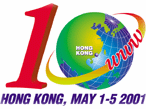
WWW10 Conference Local Guide
| WWW10 Home |
| Contact Us |
For further enquiries, please contact the Local Arrangements Chair at local@www10.org.hk.
Convention Centre
Overlooking famed Victoria Harbour, the Hong Kong Convention and Exhibition Centre (HKCEC), located at the business hub of Hong Kong - bustling Wanchai district, is a modern purpose-built complex for conferences and exhibitions opening in 1997.
Also nearby are the MTR - Hong Kong's modern subway system - the airport bus, city buses and ferries, banking, the main post office, and all the shopping and entertainment that Hong Kong is famous for.
Accommodation
Hotel facilities in Hong Kong are among the world's best. Ranging from super deluxe to modest tourist class, they offer the highest possible standard of comfort and service. Many of them are managed by renowned international chains. Currently, Hong Kong has over 35,100 rooms in over 90 hotels.
A variety of choices are offered for WWW10. All hotel venues, ranging from 3-star to deluxe class, are conveniently located in the city centre. Please check the map of the hotel index (by area) to locate your preferred hotels.
We have negotiated with some hotels for a special discount for WWW10 delegates; Please click here for more information.
Transportations
The Hong Kong International Airport is well connected with a highly efficient and comprehensive transportation network. The most convenient way to your hotel is to take the Airport Express train and get off either at its Kowloon or Hong Kong station. There are free shuttles connecting the station with major hotels in Kowloon (from the Kowloon station) or Hong Kong (from the Hong Kong station) if you do not have a lot of luggage. Otherwise, a taxi will quickly deliver you to the hotel. Please click here for more information.
Hong Kong is geographically compact, with plentiful taxis and excellent public transportation options, so travel is generally quick and easy:
- Taxis - Fares are comparatively low. The basic flag fall rate is HK$15 (US$1.92) for the first 2 kilometres in Kowloon and on Hong Kong Island, and the meter adds on HK$1.40 (US$0.18) every 200 metres.
- Buses - Double-deckers and coaches have their final destinations marked in English and Chinese on the front top panel. Fares are low [ranging from HK$1.20 (US$0.15) to HK$45 (US$5.8)]
- Ferries - The Star Ferry, Hong Kong's most scenic (and inexpensive) mode of travel across Victoria Harbour, celebrated 100 years of service in 1998. Other ferry services are available to the New Territories, outlying islands as well as mainland China and Macau.
- Minibuses and maxicabs - Minibuses and maxicabs are small passenger vans that differ by their colour. Fares for both are bit higher than buses, usually in the HK$1.50 (US$0.19) to HK$20 (US$2.57) range.
- Trains - The Mass Transit Railway (MTR) is fast, clean, efficient and inexpensive (route map and fares). The Kowloon Canton Railway (KCR) is a commuter railway that runs from Hung Hom in Kowloon to the boundary with mainland China. The Light Rail (LR) connects the New Territories towns of Tuen Mun and Yuen Long.
- Peak Tram - A quick way to Hong Kong's highest point. This cable railway has been operating since 1888, and climbs 373 metres to Victoria Peak in eight minutes.
- Hongkong Tramways - Running along the harbour side of Hong Kong Island, double-decker trams rock, rattle and roll along the same tracks they've travelled over since 1904, offering one of the best views in town. Flat fare only at HK$2 (US$0.25).
- Car Hire - Chauffeur-driven cars are widely available.
Dining
Hong Kong is famous for diverse dining facilities and great food. Diversity does not simply come with different nationality of food but also the excitement of each individual dining place. Whether you are a budget or luxury eater, good food is easily found throughout the territory. Hong Kong-style food is not to be missed. Once you try, you will never forget its richness and aroma. Brilliantly lit, many of the food stalls stay open until the early hours to facilitate late diners. A list of recommended restaurants can be found here.
Weather
Hong Kong has a subtropical climate with distinct seasonal changes. Typhoon season is May through November. During the spring (March - mid May), temperature and humidity rise. Temperatures range from 18o - 27oC (64o - 80o F). Humidity averages about 82 percent. In the summer (late May - mid September), it is hot and humid. Temperatures range from 26o - 33oC (78o - 91oF). Humidity can rise above 86 percent. Check the current weather in Hong Kong here.
Currency Exchange
Since the mid-eighties, the Hong Kong Dollar has been pegged to the US Dollar at HK$7.80 to US$1.00. The stability of the Hong Kong Dollar makes budgeting easier for both conference organisers as well as delegates. Hotels often charge a hefty fee for currency exchange.
Banks usually open from 9am to 5pm from Monday to Friday, and 9am to 1pm on Saturdays. Also, you can easily get money exchange from money exchangers in tourist areas like Wanchai and Tsimshatsui. Check here for reference exchange rate.
Pre/Post Conference Tour
Take advantage of Hong Kong's ties and transportation to Mainland China and explore the cities, culture and countryside of one of the most fascinating destinations on Hong Kong's doorstep. China Travel Service has more information about different tours and other useful information.
Besides, you can explore Macau and other unforgettable sights in Hong Kong.
Language
About 96% of the population is Chinese. Chinese and English are the official languages. Cantonese is the most widely spoken Chinese dialect, though use of Mandarin (Putonghua) is growing. All major signage is in English or is bilingual.
Useful Links